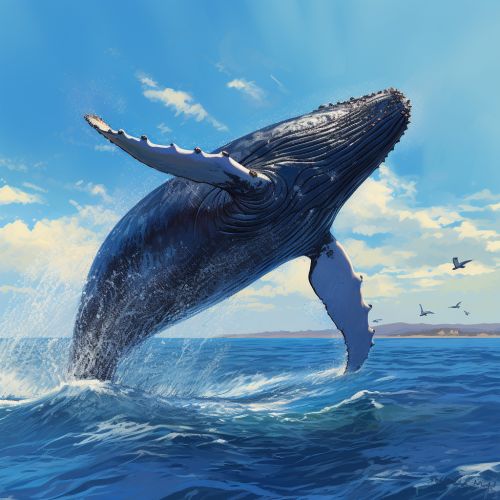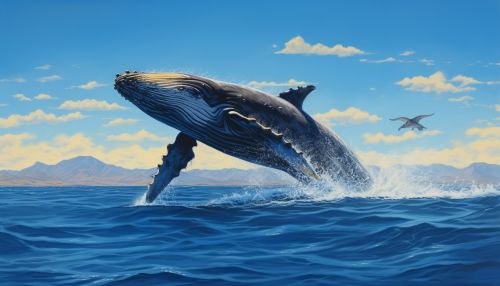Whale
Introduction
Whales are a widely distributed and diverse group of fully aquatic placental marine mammals. They are an informal grouping within the infraorder Cetaceans, usually excluding dolphins and porpoises. Whales, dolphins and porpoises belong to the order Cetartiodactyls, which consists of even-toed ungulates. Their closest living relatives are the hippopotamuses, having diverged about 40 million years ago.


Anatomy and Morphology
Whales are known for their impressive size, with the blue whale being the largest animal ever known to have lived on Earth. Their body structure is streamlined to reduce drag while swimming, with a layer of blubber under the skin for insulation in cold waters. The forelimbs, or flippers, are paddle-shaped with a skeletal structure similar to that of a human hand. The tail fin, or fluke, is used for propulsion by vertical movement, while the back fin is used for stability in swimming.
Physiology
Whales are warm-blooded, and have a layer of fat, or blubber, under the skin. With this blubber, they are adapted to the cold ocean temperatures. Unlike land mammals that lose heat through the skin to the air, whales have reduced heat loss through a thick layer of blubber, and can maintain a stable body temperature higher than that of the surrounding water. Whales have a respiratory system that allows them to stay submerged for long periods of time while still taking in the necessary oxygen. A whale's lungs are adapted to withstand the physical pressures created by diving deep underwater.
Behavior
Whales are known for their complex behavior. They are often seen breaching - jumping out of the water, and slapping the water surface with their flippers or tails. These behaviors have several proposed explanations, ranging from playfulness, to communication, to the removal of parasites. Whales are also known for their songs, complex sequences of moans, howls and cries that can last for hours. These songs are used in mating rituals and in individual identification.
Diet
Whales are carnivorous. The diet of a whale depends on its species. It can range from microscopic plankton to large marine mammals. Filter feeders, like the blue whale, feed by straining huge volumes of ocean water through their baleen plates, which act like a sieve. This method of feeding allows them to consume several tons of food each day. Toothed whales, like the sperm whale, hunt larger marine creatures such as seals and squid.
Conservation
Many species of whales have been overhunted and are currently endangered. The International Whaling Commission (IWC) has put a moratorium on commercial whaling to allow whale populations to recover. However, some countries still practice whaling under the guise of scientific research, and illegal, unreported and unregulated (IUU) whaling also remains a problem. Conservation efforts are focused on reducing these threats and preserving the habitats of whales.
